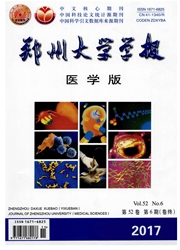

 中文摘要:
中文摘要:
目的:研究钙敏感受体(CASR)基因启动子区甲基化状态与食管鳞状细胞癌(ESCC)发生之间的关系,探讨CASR甲基化作为潜在的ESCC早期诊断标志物的可能性。方法:采用甲基化特异性PCR(MSP)方法分析6株食管癌细胞系、8例正常食管黏膜组织以及68例原发ESCC组织中CASR启动子区的甲基化状态。采用半定量RT-PCR方法分析甲基化酶抑制剂5-氮杂-2'-脱氧胞嘧啶核苷(5-Aza)处理前后食管癌细胞系中CASRmRNA的表达情况。结果:5株食管癌细胞系(KYSE30、KYSE70、KYSE140、TE8、BIC1)CASR启动子区发生甲基化,而KYSE510未发生甲基化。KYSE30、KYSE140细胞系CASR基因表达缺失,5-Aza处理96h后恢复表达;而KYSE510处理前后均有表达。在68例原发ESCC组织中,CASR启动子区甲基化率为71%(48/68),而在8例正常食管黏膜组织中CASR启动子区均未甲基化(0/8)。CASR启动子区甲基化与ESCC患者的年龄构成(χ2=1.114,P=0.291)、性别(χ2=0.342,P=0.558)、肿瘤位置(χ2=1.209,P=0.546)、临床TNM分期(χ2=0.181,P=0.670)及淋巴结转移(χ2=1.169,P=0.280)无关。结论:CASR基因在ESCC组织中的表达受启动子区甲基化的调控;CASR启动子区甲基化在ESCC组织中频繁发生,可能作为食管癌早期诊断的潜在标志物和治疗靶点并在其发生发展中起重要作用。
 英文摘要:
英文摘要:
Aim: To investigate the promoter region methylation status of calcium-sensing receptor( CASR) in esopha-geal carcinogenesis,and to explore the possibility of CASR promoter methylation as a potential biomarker for human esopha-geal squamous cell carcinoma ( ESCC) . Methods: The promoter region methylation of CASR in 6 esophageal cancer cell lines,8 normal esophageal mucosa and 68 primary ESCC tissue samples were investigated using methylation specific PCR. Semi-quantitative RT-PCR was used to evaluate CASR expression levels before and after treatment with 5-aza-2'-deoxycyti-dine ( 5-Aza) in cell lines. Results: Methylation of the CASR promoter region was detected in 5 cell lines ( KYSE30, KYSE70,KYSE140,TE8 and BIC1) ,but not in KYSE510. Loss of CASR expression was found in the methylated cell lines. Re-expression of CASR was induced after 5-Aza treatment for 96 h. In 68 cases of human primary ESCC tissue sam-ples,the methylation rate of CASR promoter region was 71% ( 48 /68) ,but no one was methylated in 8 cases of normal e-sophageal mucosa( 0 /8) . No association was found between promoter region hypermethylation and age( χ 2 = 1. 114,P = 0. 291) ,gender( χ 2 = 0. 342,P = 0. 558) ,tumor location( χ 2 = 1. 209,P = 0. 546) ,tumor stage( χ 2 = 0. 181,P = 0. 670) or lymph node metastasis( χ 2 = 1. 169,P = 0. 280) . Conclusion: The methylated CASR frequently exists in primary hu-man ESCC,suggesting it may be used as a potential early detection biomarker or target for this disease.
 同期刊论文项目
同期刊论文项目
 同项目期刊论文
同项目期刊论文
 Epigenetic silencing of DACH1 induces loss of transforming growth factor–β1 antiproliferative respon
Epigenetic silencing of DACH1 induces loss of transforming growth factor–β1 antiproliferative respon 期刊信息
期刊信息
